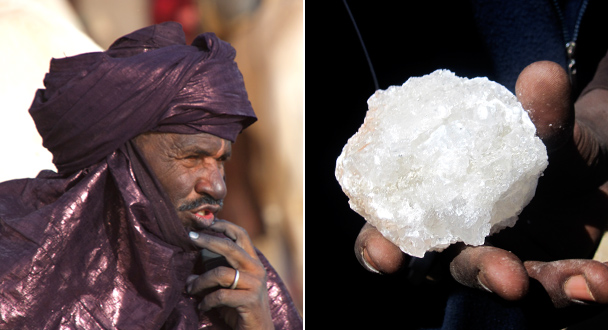Once upon a time, centuries before container ships and cargo planes crisscrossed the globe, wealthy Europeans would sit down to dinner and judiciously sprinkle a few precious crystals of salt onto their food. In many cases, this priceless seasoning (which, in the days before refrigeration, was also the primary way to preserve meat and other staples) had come from mines deep within the Sahara, a continent away, traded along its journey for glass beads, gold, or slaves.
The simple seasoning we now take for granted spurred some of the first major trade routes from Africa to Europe, and was carried overland by camel caravans known as azalai, bound for ports in what is now Senegal, Ghana, and Morocco. Desert towns like Djenné and Timbuktu sprang up to support the traders, as spices, beads, and cowrie shells from north and east Africa were traded for slaves and gold from southern and western Africa. And there, in the middle of the desert, thousands of miles from Europe’s tables, was the source of the most precious element of all: salt, the only commodity that was literally worth its weight in gold.
These days, salt may be easier to procure and less precious in our estimations, but in many ways, the journey made in northwestern Africa by this essential mineral is just as treacherous as it was in the Middle Ages. And the dangers to those transporting salt—including robbery and death from exposure or thirst—persist, as well. This winter, I retraced some of this same terrain in central Mali, traveling by car over the course of three weeks. Little did I know that in the months to come, a military coup and rebel battles would overtake the nation, introducing new risks and effectively doing what plains, trains, and automobiles couldn’t do: kill the Salt Road. [As of our date of publication, April 11, no one is allowed in or out of the Tuareg rebel–controlled areas.]
My journey began about a two-hour car drive south of the famed town of Timbuktu. The 125-mile-long Bandiagara Escarpment, an unforgivingly steep sandstone ridge, has been inhabited for centuries by the Dogon people, animists who fled Arab raiders more than 800 years ago from the fertile headwaters of the Niger River to preserve their way of life. The Dogon live in adobe houses built high into the cliffs, and grow most of what they need to survive in this formidable landscape (including sorghum, millet, and onions). The Escarpment became a landmark along the ancient salt trade route by virtue of its location in the Sahel Desert south of the Niger River, which curves through Mali: For as long as the Dogon have lived here, salt has passed through the region, part of a journey that starts more than 550 miles away in the mines of the Saharan outpost of Taoudenni.
Moving north through the Sahel, alongside the pothole-studded dirt road that connects the Dogon lands to Timbuktu, we come across donkey caravans: dozens of animals laden with huge slabs of salt that resemble white granite.
One might mistake this for a scene from the 1800s, but today life on the Salt Road goes on much as it has for nine hundred years, only now the donkeys outnumber the camels, and the animals themselves are eclipsed by the cars and trucks that have become today’s preferred salt-haulers.
“Salt has always been needed for the cattle,” explained Sory, a Fulani tribesman from the ancient city of Djenné and the guide who’d traveled with me from the capital city of Bamako to Timbuktu. “Without salt the cattle will die—land here a man has always counted his wealth in cattle. Even now, cattle are our form of banking. You can’t get married without a dowry of cattle or do business without it. So without salt, you have no cattle, no prosperity, nothing.”
With the success of the salt trade, wealth flowed into Timbuktu. The city, and other towns along the route, were not only enriched by the goods exchanged in these ancient markets but also transformed by the Islamic faith practiced by the traders. In the 13th century, Arab merchants—including Berbers and Tuaregs—from the north brought with them the Koran and written language to the mostly animist tribes of the south, which had previously relied on oral tradition to communicate. “In order to do business with the Arabs, you had to be Muslim, so kings and tribes converted,” Sory explained. But the tribes also learned how to read and write—thus opening up their societies to the rest of the world.



 Pinterest
Pinterest


